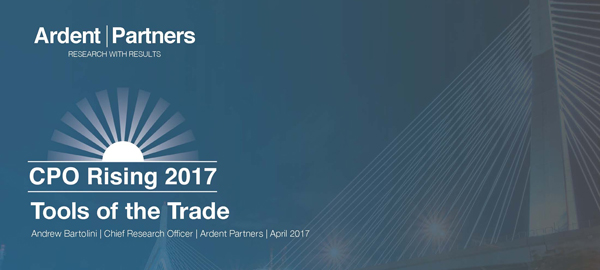We recently published my twelfth annual CPO-themed report, CPO Rising 2017: Tools of the Trade, which is part of an ongoing dialogue that my team and I have had with Chief Procurement Officers (CPOs) and other procurement leaders for more than a decade (I began writing a version of this report in 2006). Over the next few weeks, we’ll be discussing the report in a series of articles on this site. (I should note that report theme is also tied to Ardent Partners’ annual CPO Rising Summit set for November 8 & 9 in Boston).
The report examines the general competencies and capabilities of procurement organizations today and highlights the management strategies and tactics that leading CPOs use to get the most from their teams. It also presents a comprehensive, industry-wide view into what is happening in the world of procurement and captures the experience, performance, perspective, and intentions of 313 CPOs and other procurement executives. You can get the report here (registration required).
Each CPO Rising report has a overarching theme (captured by its subtitle). Over the years, I have tackled a broad range of issues in the report from procurement agility and innovation to talent development/management and performance measurement. This year, for the first time, we look at technology tools (“tools of the trade”). When I started working on the report and developing the research thesis, I surprised myself when I realized that this is the first year where technology is the central theme of the report. We certainly write a fair amount about technology, but our stance has always been that other areas matter to CPOs, too.
Bridging the Technology Gap
Supply management technologies have played an important role in helping to drive the procurement profession forward. During the heady days of the B2B internet craze, supply management technology frequently topped the list of popular, modern technologies and a global revolution seemed imminent. The reality is that most new technology trends fall short of initial expectations and predictions on growth and adoption, and this market was no different. To start, new technology segments are usually created by a group of visionaries who have identified an opportunity or problem and a way for new technology to address it. Twenty years ago, the lag between the introduction of a compelling new idea or vision and the release of the technology product that enabled it was lengthy. And, there is almost always a gap between what can be imagined and sold and what can actually be built and delivered. Supply management technology fell into this same trap. An amazing vision and opportunity for procurement was not matched by the earliest solutions in the market and the first wave of this industry crashed. It took time, but the solution providers that survived and the new ones that emerged have been able to get the industry back on course. Supply management technologies have been used successfully by many procurement departments, but they are certainly not universally adopted. This is a major industry question and one that the report tries to both answer and solve. From the report:
After all, there is no profession where a true master tradesman intentionally lays aside the core tools and equipment of their craft – skill, creativity, and dedication cannot replace them. While budget and resource constraints as well as perceived complexity often hinder investment in supply management technology, it has been clear for some time that some Chief Procurement Officers simply do not consider these solutions to be essential to what they are trying to accomplish. These CPOs are predominantly from an older generation and, while mistaken, come to their views honestly with careers that began well before the solutions first launched twenty years ago. Nonetheless, just as today’s competitive market pressure and unprecedented innovation demand the constant reevaluation of supply markets, so too must these leaders rethink their technology strategies. Those CPOs that continue to resist automation and the other changes needed to enhance agility are manufacturing their department’s obsolescence. The time has come for many of these “old masters” to stop acting like apprentices and adopt a 21st Century approach to their business.
Although far from perfect, the supply management solutions available in the market today have advanced significantly since the early days and come much closer to modeling procurement’s common processes and supporting their desired outcomes. But to make a significant impact, they must be both well-adopted and well-used.
Get the CPO Rising 2017 report.
RELATED RESEARCH
CPO Rising 2015: The Agility Agenda (Report) is Now Available
CPO Rising 2011: 1nnovative 1deas… A New Report from Ardent Partners
CPO Rising: Keeping Score (Report Now Available)
CPO Rising 2016: The Art and Science of Procurement

